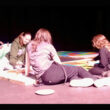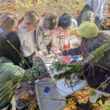Sweet Home’s relief organizations are struggling, but the biggest needs aren’t food resources or money.
It’s volunteers.
That’s the biggest takeaway from a meeting held Thursday morning, Nov. 6, to assess the food needs in Sweet Home over the winter months. The meeting, organized by Mayor Susan Coleman and her husband Pastor Matt Coleman, Chamber of Commerce Executive Director Lagea Mull and school district Supt. Terry Martin, was held in the Sweet Home School District Board Chambers. It drew a crowd of some 40 people including representatives of multiple organizations that provide meals and food support for the needy, school district representatives, and various other community leaders.
“We’ve just reached a crisis point where our neighbors are hungry,” Martin said, noting that in Dallas, cutbacks by the U.S. Department of Agriculture, which administers the Supplemental Nutrition Assistance Program (SNAP), also known as “food stamps,” have reduced the local intake by 6,000 pounds a week.
“We’re putting politics aside. What can we do for our community?
“Sweet Home rallies when the chips are down and that’s where we are right now.”
According to Sweet Home School District statistics, 1,340 (37.8%) of Sweet Home city households receive food stamp benefits, while the number for the entire school district is 1,828 households (31.6%), which is nearly double the rate for the state of Oregon and 10% higher than Linn County as a whole.
Oregonians on SNAP total 757,000 people, which, Martin noted, is about 450,000 families, including 150,000 children. .
He said the school district provides free breakfast and lunch for all students, and that about 60% take advantage of the food.
“If kids are hungry, they can’t learn,” he said, “and we’re hearing all across that they are.”
The state typically reimburses the district every three months for those meals, but has dropped reimbursements to monthly. He said the district plans to continue its meals program.
But with talk of SNAP benefits being cut 50%, and with inflation factored in, “you know that if someone’s going to get half of what they used to get, it’s a time of absolute crisis.”
“We can do better,” Martin said. “We can do better.”
Organizations Report Status
Susan Coleman said that the goal of the meeting was to “hear the needs and then find solutions to those needs.”
She polled representatives of various local organizations sitting around the table on what their needs are.
Joseph’s Market/Reigning Glory – Pastor Lynn Cooper reported that the ministry, which distributes food on Tuesday afternoons at the corner of Oak Terrace and Holley Road, pays costs totalling about $2,500 a month for insurance, electrical costs and building expenses.
She said her small congregation is “footing most of the bills” and food recipients contribute what they can,
“I love how the people come in and give what they can,” Cooper said, adding that the donations total from $20 to $75 per week.
Sweet Home Emergency Ministries – Cindy Rice and Julie Dedman reported that SHEM fedf 1,205 people last month, who visited to receive weekly food boxes containing enough food to last several days. Some also received “supplemental” boxes with additional food.
The monthly financial need for providing SHEM’s services is $4,875, but the two said that SHEM’s biggest need is personnel.
“We need 28 volunteers every week,” Dedman said.
Rice invited community members to stop by at SHEM and check it out “for 10 to 15 minutes.”
“Prepare to have your eyes wide open.”
Manna Meals, which is a subsidiary of SHEM, are served three nights a week at the Sweet Home United Methodist Church at 6th Avenue and Juniper Street. Linda Rowton, who directs the program, said the meals will probably need to cease by the end of the year if more volunteers don’t materialize. She said that often there are only two volunteers preparing, serving and cleaning up after meals. The youngest of their volunteer corps, she said, is “60-something.”
Hope Church Food Bank – Pastor Mark Opperman said his church serves 40 to 50 families per week on the first and third Mondays of the month.
He said the ministry operates on a “shoestring budget” of about $400 a month, which is included in the church budget.
Sugar City Gleaners – Theresa Howard reported that insurance and fuel costs total about $5,000 a year for her organization, which raises money through its thrift store at 3031 Main St.
She said their building needs a new roof, but the biggest need is volunteer help.
“We need volunteers to help in the store,” she said, adding that Sugar City has about 20 volunteers, “but they’re burning out. We need some fresh blood.”
Kids Food Pak – Toy Royer said her organization, which provides weekend food for needy students, relies primarily on fundraisers and donations. She said that Kids Food Pack gets a lot of its food from Linn-Benton Food Share, and that its focus is mostly on canned goods, pasta and non-perishables.
“Because we’re serving kids, we don’t use fresh stuff, that’s free,” she said. Costs have more than doubled, to “$7,000, $8,000 per year.”
She said she has a “pretty good crew” who show up on Thursday mornings to prepare food packs.
“We could use a few more,” she said.
Royer noted that donated food, such as canned items, tend to be “95% outdated,” and suggested that donations should be “date-appropriate, and for me, kid-friendly.”
Cooper, of Joseph’s Market, said that expiration dates “don’t mean a lot,” and that they are “just suggestions” and the contents are often fine.
“Don’t get rid of it, don’t throw it away,” she said. “There are organizations that will take it.”
Fairshare Gleaners – Jeff Kershau reported that his organization serves 280 families per month, with typical weekly distribution going to 80 to 120 people. Fairshare gets donations from stores, which are unloaded weekly from the organization’s truck by volunteers, which are needed.
Meals on Wheels – A representative was not available from the weekly meals delivery service to seniors, but Susan Coleman and Jo Ann McQueary said that Monday deliveries have been halted in Sweet Home because of a lack of drivers. Meals are still delivered on Wednesdays and Fridays.
McQueary said that Meals on Wheels has enough resources to provide three in-person delivered meals a week “but they need volunteers.”
‘Tangible’ Response?
Mull, chamber director, asked the audience for “tangible” ways the community can respond to the needs expressed.
“We already have resources,” she said. “We need to man the organizations we have. We don’t need new ones.”
Former Mayor Jim Gourley, representing the Rotary Club, said: “We’re going after the same volunteers over and over. We’ve got to figure out a way to get other people in the community (to volunteer).”
Randy Claussen of the Sweet Home Elks Lodge said he would take information from Thursday’s meeting on volunteer needs to the Elks.
He also said the Elks are planning a spaghetti feed at the lodge and are hoping to have the high school band, which the Elks have been financially supporting in efforts to restore the quality of the program, perform at the event as a fundraiser.
He noted that the Elks are finishing up a remodel of their facility, which should be completed by the time the fundraiser is held, so the public can see the results.
Also, he said, the Elks give out annual scholarships to students with community service requirements for recipients.
Bob Dalton, a longtime member of the city Health Committee, asked for ideas to stretch dollars for local organizations, suggesting options such as asking utility companies for grace periods, rent reductions or waivers for outreach programs, insurance rate reductions.
He also said the Health Fair, which he has organized since it began, “has a huge list of organizations” that might be able to provide resources or volunteers.
“For those who have volunteers, they could cross–share,” Linda Rowton suggested..
Business, Others Step Up
TJ Hiner, of Big Bark LLC, which operates chipper crews and wildland firefighting operations, said that his seasonal employees take advantage of services offered by the organizations in the room.
He pledged $5,000 to Sugar City Gleaners immediately, and his wife Jackie Hiner said later that Big Bark would contribute another $5,000 in December to the Gleaners.
TJ Hiner said he understands the need.
“This is a conversation I’m having every day with every one of my employees,” he said, adding that he regularly has “kids eating out of my refrigerator” because they don’t have food at home.
Megan Dazey of the Sweet Home Library said the library has started a food pantry “to fill the gap” and that 15 to 20 people had donated food in the few days the effort had been operating.
“Teens have been choosing food over candy, which should tell you something,” Dazey said, adding that although they could be oversaturated with Halloween candy, making such choices “is rare for kids.”
Participants discussed how some local organizations are limited by government regulations in what they can accept as food donations.
Efficiency Suggestions
Mull suggested that donors will “get more bang for your buck” by donating cash.
Linn Benton Food Share can acquire and distribute the equivalent of five meals for every dollar donated, according to handout circulated at the meeting.
Larry Horton, representing the Rotary Club, said he has service club members in high school- and junior high who could provide volunteer hours.
Horton, retired as Sweet Home’s former school superintendent and a key player in the organization of the community homeless shelter, suggested that efforts of various groups in the community could be consolidated for more impact and efficiency.
He also suggested establishing a position for a paid coordinator who could oversee the groups’ efforts and who could likely increase the success rate for grant applications from Sweet Home.
“In my mind, we need a central leader to oversee all of these,” he said.
He suggested that the city could assist with those efforts.
Coleman responded that she was “a little hesitant” to have the city get too involved in relief work.
“Helping neighbors is something we all do much better job at than government,” she said.
Norina Colunbaro of SHEM suggested that college students could volunteer in local aid organizations.
“It’s good for us to serve each other,” she said. “It works differently for each of us. Start serving, then invite somebody else to go along.”





